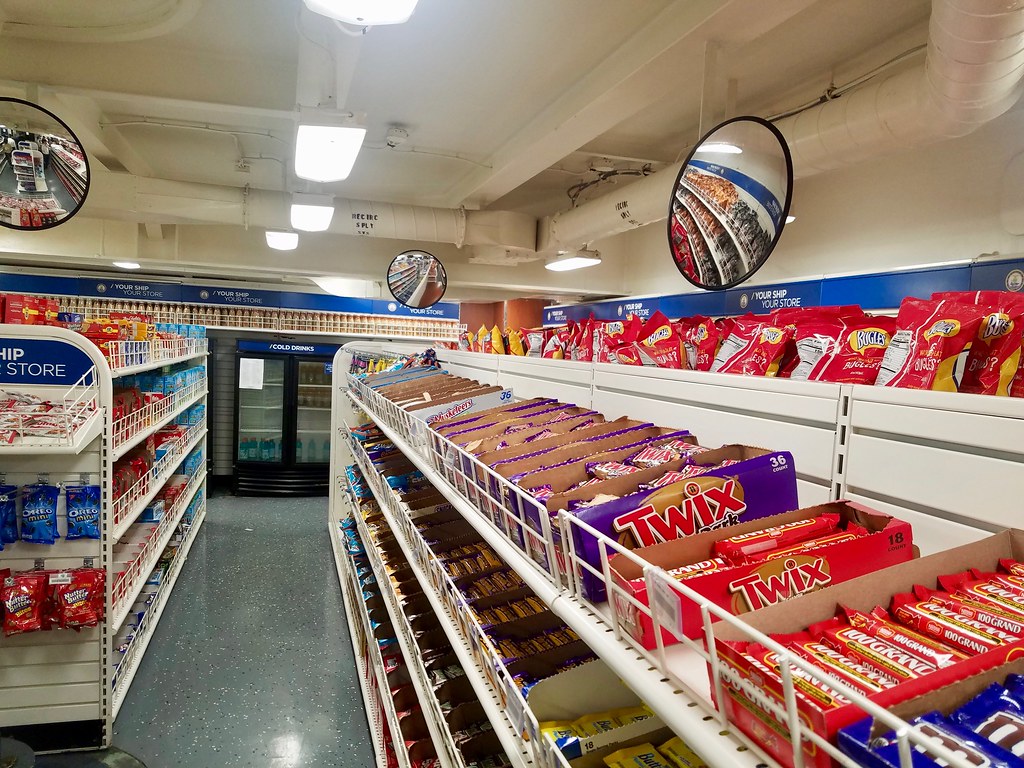Jets roared from the deck of the USS John C. Stennis around the clock, the most visible sign of its power. However, the ship needed thousands of people to keep this one vital function going and they all needed to be fed around the clock. The massive effort to procure, load, store, cook and clean shouldn’t be overlooked for its important supporting role. Several hundred crew members focused their efforts on food services alone.
Storage

The carrier contained refrigerated and dry storage areas on a lower deck, filled with with many of the same items seen in a commercial supermarket. Refrigerated areas felt pretty good to me after sweating in parts of the ship that lacked air conditioning.
The appetites and tastes of American sailors mirrored their onshore peers and the Navy did its best to cater to those preferences. Ships followed a common menu to a degree, eating similar foods on the same day no matter where deployed.
Supply personnel tried to replenish their stores weekly whenever possible. They tapped into preexisting contracts with major wholesale distributors, with food shuttled to the ship as it passed near ports. However, sometimes the ship might be too far out to sea. At those times the crew could tell pretty easily because the fresh foods began to disappear, replaced by canned or dried. We didn’t have that issue though and we ate well.
Cooking

Multiple kitchens existed throughout the ship. These tended to be very busy places so we went to one that was a little quieter at the time, the bakery. Of course that gave us the added benefit of cookies fresh from the oven. It tasted like home. But the temperature soared in that confined, interior space with all of the ovens blasting. I enjoyed that part of the tour and also felt relieved when we moved somewhere a little cooler.
Serving
Rank meant a lot on the ship and that extended to food services too. As Distinguished Visitors, our status equated to a fairly impressive rank and it bestowed privileges ordinarily granted to officers. Even so, the Navy wanted us to get the full experience so we ate each meal with a different group.

We started at the top of the food chain, a dinner in the officer’s wardroom at the captain’s table. I sat between the Executive Officer and the Supply Officer and had a nice opportunity to learn even more about the ship. This was our most formal meal of the visit, with assigned seating, folded napkins, real silverware, and upholstered chairs. Officers had it pretty good.

We had breakfast the next morning with the Chief Petty Officers. These senior enlisted crew earned their positions after serving with distinction and climbing the ranks for many years. They provided a vital link between the officers and the young, inexperienced sailors that labored throughout the ship. Truly, the CPO cadre knew more about keeping things running than anyone else. They got their own mess hall in recognition of their well-earned status.

Everyone else, the vast majority of the crew actually, ate in the enlisted galley. They packed into crowded utilitarian spaces between shifts. However even here they got a nice selection of food served cafeteria style. The carrier never stopped working and the galley reflected the need; meal service continued 22 hours per day (and other food options existed even during the other 2).
Always More

Otherwise sailors could always go to the ship’s store. It seemed to be a junk food paradise with all the brands and comforts of home. Interestingly, cash could not be used anywhere on the ship. Every crew member used something similar to a debit card at the store. I couldn’t imagine why anyone would need to stop here in a basically “all you could eat” environment although it seemed to be a popular choice. I asked the Supply Officer and he had basically the same bewilderment, describing it as one of the carrier’s great mysteries.
And if that weren’t enough, the ship also had a coffee shop and vending machines. No wonder they brought a Fit Boss along.
Articles in the Aircraft Carrier Series
- Getting to Norfolk
- All Aboard
- Air Power
- The Island
- Living Aboard
- Feeding Time
- Always Working
- Other Spaces and Places
See Also: The Complete Photo Album on Flickr

Leave a Reply